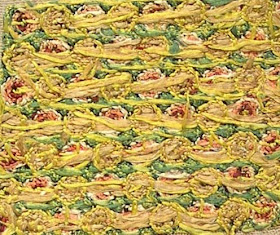.jpg)
It is not possible for everyone to see sampler reverses. In many cases the samplers are framed and cannot be taken out of their frames without considerable expense and some risk. But I have seen and imaged around two hundred early examples which is enough to make a decent sample size to study and analyse. When I first started studying samplers I was told by different people on a number of occasions that early stitchers were very frugal with silk - because it was most expensive - and so floss was conserved by not taking it through to the reverse, or by using stitches which were worked on the surface only.
.jpg) From my experience and analysis I can now say that I have rarely seen evidence of this sort of frugal practice. The vast majority of early samplers that I have been able to examine have the same amount of floss on the reverse as the front - and sometimes more in places where the stitches are quite congested as you can see from this 18th century example here. There are exceptions. The first is when metallic threads are employed. Metallic thread was expensive and would have been used frugally. But the main reason why metal thread was rarely taken through to the reverse is that it would have cut and shredded the cloth rather like a fret saw. The other instance is when the intention is to produce a detached or raised surface stitch. But this was done to display technique and artistry, not to conserve thread. Where surface stitches are demonstrated on samplers, the use of thread on the rest of the sampler follows the pattern of usage on other samplers.
From my experience and analysis I can now say that I have rarely seen evidence of this sort of frugal practice. The vast majority of early samplers that I have been able to examine have the same amount of floss on the reverse as the front - and sometimes more in places where the stitches are quite congested as you can see from this 18th century example here. There are exceptions. The first is when metallic threads are employed. Metallic thread was expensive and would have been used frugally. But the main reason why metal thread was rarely taken through to the reverse is that it would have cut and shredded the cloth rather like a fret saw. The other instance is when the intention is to produce a detached or raised surface stitch. But this was done to display technique and artistry, not to conserve thread. Where surface stitches are demonstrated on samplers, the use of thread on the rest of the sampler follows the pattern of usage on other samplers.

Ahhh. Thanks for sharing this. I cringe when people want to see the back of my work. While I'm careful to avoid passing dark threads underneath where they might be seen through the front, I've decided that the front and my peace of mind is more important. So I stitch mostly without regard to how the back will look. (I do try to avoid any "clumping" so that the finished piece will lie flat in it's frame... as if I ever got anything framed.)
ReplyDeleteThanks again!
Thanks for the information. Just to share with you and other readers, I attended a lecture by Joanne Harvey several years ago. She has a slide that she shows of a sampler that she examined one time that shows exactly what you are saying. She starts out taking about this subject and shows the back of the sampler. It is a complete mess to say the least. Then she shows the front and it is breath-takingly beautiful, to say the least. It really inpressed on me that it doesn't matter what the back looks like it only counts what the front looks like.
ReplyDeleteVery interesting. From looking at the samplers that were cross-stitched, can you tell us whether most were stitched Danish fashion or crossing one stitch at a time? Were motifs worked in vertical columns or horizontal rows? I'm curious because I prefer columns to rows and I cross all my stitches the "wrong" way.
ReplyDeleteMY forte is blackwork, not samplers, but you wouldn't believe the number of people who insist that blackwork items MUST be reversible, the backs MUST be perfect and indistinguisable from the front, etc. I think a great deal of this "perfect backs" emphasis is a leftover from our beloved but somewhat anal-retentive Victorian aunties and grandmas...
ReplyDeleteCan you tell us if most of the cross-stitch samplers were stitched Danish-fashion or a stitch at a time? Worked in columns or rows? Do most of them have the crosses worked with the same leg on top. (Apologies if this posts twice--I think my first attempt was eaten.)
ReplyDeleteAn interesting question Monique. From what I have seen every possibility seems to coexist side by side on the same sampler for the majority of samplers....!
ReplyDeleteWhile I do try to do blackwork reversable (if it`s not reversable, why not do backstitch?)and be neat on the back of my samplers, I don`t go into spasms about it. I have been experementing with the pinhead start, but am not confident it won`t come undone over time....
ReplyDeleteWhile attending a program for the Carolina Sampler Guild a number of years ago, Margarite Hogue,the featured speaker, was commenting on this same phemomena of incredibly untidy amtique sampler backs. Her advise to us: "Americans are entirely too preoccupied with their backsides!" which brought down the house! And opened our eyes to our OCD ways of stitching!
ReplyDelete